Thermaltake Suppressor F51 and Water 3.0 Ultimate
Review:If imitation is the sincerest form of flattery then it is clear that Thermaltake thinks highly of the Fractal Design Define R5. The new Thermaltake Suppressor F51 doesn’t so much pay a nod to the R5 as borrow all its best ideas, work on the weak areas and then add in a couple of new features.
Watch via our VIMEO Channel (below) or over on YOUTUBE
Indeed the Thermaltake Suppressor F51 is delivered as a quiet case with loads of sound deadening but if you pull out various drive towers and open some vents you effectively end up with the Fractal Design Define S with the addition of air filtering. This is significant as we were impressed by the S but criticised the absence of air filtering in the roof of the case.
As you will see in the video the two side panels are lined with noise deadening material and the roof of the case is sealed. The front of the case has a novel double air filter design as well as a stealth door that covers the two 5.25-inch drive bays. Air can flow freely past the 200mm intake fan but makes no noise in the process. Those front filters combine with two filters in the floor of the case and a magnetic filter on the top of the F51, however this only plays a part if you remove the top panels in the case as part of the procedure for installing liquid cooling (or extra case fans).
Inside the case you can remove the two drive towers to open up a large amount of space and can also remove the two optical drive bays. There are mounts on the rear of the motherboard tray where you can hang two of the caddies from the drive towers. Alternatively, if you keep the 5.25-inch bays you can mount a single 3.5-inch drive or two 2.5-inch drives. There are many, many configurations available.
With the top or front (or the top AND front) of the case opened up you can install a radiator up to 420mm in length. This is likely to be in the roof of the case as you won’t want to ditch that 200mm intake fan without good reason. If you go down this route you can mount a Water 3.0 Ultimate or Extreme system in the roof or a slimmer Water 3.0 Performer or Pro system at the front.
Experimenting with the Pacific RL240 custom loop kit demonstrates there is plenty of room to install the pump/reservoir and other hardware.
Specification:
- Motherboard support: E-ATX, ATX, mATX, Mini-ITX.
- Expansion slots: 8.
- Included fans: 1x 200mm front intake, 1x 140mm rear exhaust.
- Fan mounts: 2x 120/140mm front, 3x 120/140mm roof, 1x 120mm rear, 2x 120/140mm floor, 1x 120/140mm side.
120mm radiator mounts: 120mm/240mm/360mm front, 120mm/240mm/360mm roof, 120mm rear, 120mm/240mm floor.
140mm radiator mounts: 140mm/280mm/420mm front, 140mm/280mm/420mm roof.- 5.25″ drive bays: Two
- Internal drive bays: 6x 2.5”/3.5” plus mounts in 5.25-inch bays
- Dimensions: 525mm H x 577mm D x 230mm W.
Building the system is fairly quick and easy as you have so much space to work with, although the cable management side of things isn’t ideal. In particular we would have liked to see more cable tie points and the routing for SATA and power cables to the rear drive caddy positions leaves something to be desired.
There is so much space inside the F51 that you can install an E-ATX motherboard up to 12 inches x13 inches along with a 310mm graphics card with the hard drive tower in place or 480mm without the towers.
If you decide to stick with air cooling you can install a CPU cooler height up to 185mm.
There is 28mm clearance behind motherboard tray for cable management which is fairly generous but the fact that there are no windows means you can be relatively cavalier about cable management, without the need to be too obsessive about tidiness.
Performance Testing
To put this case through its cooling paces we will be using a test system consisting of an Intel Core i7-4770K, Radeon R9 270 and multiple storage drives. This system allows us to produce a substantial amount of heat and effectively test the Thermaltake Suppressor F51‘s cooling capabilities.
For stress testing we use a mixture of AIDA64 and FurMark to create the maximum heat output. AIDA64 allows us to stress our CPU and FurMark’s ‘GPU Burn-in’ mode creates the maximum amount of load our GPU is ever likely to see.
Test System:
- Processor: 3.9GHz Intel Core i7-4770K
- Motherboard: ASRock Z97 Killer
- CPU cooler: Thermaltake Water 3.0 Ultimate
- Memory: Corsair Vengeance LP DDR3-1600MHz RAM
- Graphics card: Sapphire Tri-X R9 290
- Power supply: Seasonic Platinum Fanless 520W
- Storage drives: SanDisk Extreme Pro SSD
- OS: Windows 8.1 64-bit.
Cooling Performance
With the Water 3.0 Ultimate 360mm liquid cooler attached to our Core i7 there was never really much doubt the F51 would do a proper job when it came to cooling the hardware. Standing over the case there was quite a draught when the fan speed was increased to maximum (1,800rpm) but turn it down to 1,000rpm and the air flow was nothing more than a gentle breeze.
Acoustics Performance
In stock form the F51 is effectively silent. Open the top vents and install a rorty set of fans and you will indeed hear some noise but that is pretty much a matter of choice. There is no need for this case to be noisy to deliver epic levels of cooling.
Closing Thoughts
Thank goodness Thermaltake developed the Define R5 and S and added proper air filtering. The Suppressor F51 is a case that is slightly more expensive than the Fractal Design models yet it delivers options that will appeal to the casual PC builder as well as the hardcore enthusiast.
Discuss on our Facebook page, over HERE.
Pros:
- Very quiet.
- Ability to install 420mm radiator in the roof or front of the case.
- World class air filtering at the front, top and bottom of the case.
- 200mm intake fan.
- Options to remove drive towers and install drives on the back of the motherboard or in the optical drive bays.
- Supports E-ATX form factor.
- I/O panel is attached to the chassis so you can remove the front panel with ease.
- Top panels can be removed to open ventilation.
- Understated styling looks smart.
- Black plastic finish conceals fingermarks.
Cons:
- Build quality feels marginal. Some threads were stiff.
- Cable management lacks tie down points.
- Cable routing holes and grommets are slightly inadequate.
- The power button in our sample tilted in an alarming fashion.
- Routing cables to the rear drive bays was awkward.
- The sliding power supply support was tricky to move to the correct position.
http://www.kitguru.net/components/ca...-3-0-ultimate/
User Tag List
 Likes: 0
Likes: 0
Resultados 46 a 60 de 433
Tópico: Caixas PC ATX, mATX
-
04-06-15, 13:41 #46Tech Ubër-Dominus


- Registo
- Nov 2013
- Local
- City 17
- Posts
- 30,121
- Likes (Dados)
- 0
- Likes (Recebidos)
- 2
- Avaliação
- 1 (100%)
- Mentioned
- 0 Post(s)
- Tagged
- 0 Thread(s)
-
04-06-15, 13:45 #47Tech Ubër-Dominus


- Registo
- Nov 2013
- Local
- City 17
- Posts
- 30,121
- Likes (Dados)
- 0
- Likes (Recebidos)
- 2
- Avaliação
- 1 (100%)
- Mentioned
- 0 Post(s)
- Tagged
- 0 Thread(s)
Review: Corsair Carbide Series 100R Silent Edition
Toda a review:Introduction
The evolution of PC hardware is such that today's more powerful components don't run as hot or as loud as you might think. It wasn't that long ago that building a truly high-end rig required careful planning for lavish cooling solutions installed inside formidably-sized enclosures, but modern builds can afford to be smaller, simpler and kinder on the bank balance.
Makes you wonder, when using up-to-date components, can a budget enclosure cope with the demands of an overclocked CPU and multiple fast-running graphics cards? To find out, we have Corsair's entry-level Carbide Series 100R Silent Edition chassis in for review.
Retailing at £50, the 100R Silent Edition is one of Corsair's most aggressively priced enclosures to date, and yet it has an even cheaper sibling - a regular version sans the Silent Edition extras can be had for as little as £43. But said extras might be worth paying for, as the small premium brings with it sound-dampening material throughout and a built-in fan controller.
On the face of it, the 100R SE seems a neat little all-rounder, and it's not a bad-looking case, either. Measuring 471mm x 200mm x 430mm in size and weighing in at 4.8kg, the chassis is both smaller and lighter than many of Corsair's usual mid-tower solutions. The form factor makes it appear sleek and modest, while the arrangement of the front I/O ports (dual USB 3.0, headset, mic, reset and power) is simple yet tidy.
The only stumbling block in terms of aesthetics, we feel, is the bulge in either side panel. The large square bumps detract from an otherwise smooth finish, and we suspect their inclusion isn't an aesthetic choice but rather a functional one - the chassis isn't the widest, so the extra bit of space behind the side panels could prove to be useful.
Browsing the 100R SE's exterior reveals nothing out of the ordinary. Seven expansion slots are par for the course on a mid-tower enclosure, there's a small dust filter beneath the PSU bay that pulls out the back, and four plastic feet help prop the case up.
There's no filter up front, though the entire plastic fascia does pull away with relative ease, and the I/O panel is hardwired to the chassis, so there's no need to disconnect cables when removing the front cover. The only potential snag in this regard is optical drives - choose to have any installed and you may need to remove them before pulling the fascia away.
Readers weighing up the differences between the regular 100R and this Silent Edition should note that the former has a perforated top panel with dual 120mm fan mounts. In contrast, the Silent Edition's top panel is solid and lined with the same sound-dampening material present on the front and side panels.
Corsair's notched and railed side panels come away after undoing a couple of thumbscrews to reveal an interior that conforms to modern chassis standards. The PSU is designed to be bottom mounted, there's room for a Mini-, Micro- or Standard-ATX motherboard, a good-sized cutout in the tray for CPU cooler installation, as well as a sprinkling of holes for cable management and a selection of cable tie-down points.
The 100R SE has most of the basics covered, but as expected on a budget enclosure, basic is the key word. None of the cable-routing holes are equipped with rubber grommets for added tidiness, there's no hole for routing cables over the top of the motherboard - making it a pain to install the oft-awkward CPU power cable - and the entire internal area can feel cramped when using an ATX motherboard.
In an effort to put the available space to good use, Corsair has split the storage column in two, leaving two 5.25in optical bays at the top and a storage cage at the bottom outfitted with four plastic 2.5/3.5in drive trays. This arrangement leaves a path for front-to-back airflow, and Corsair provides two fans as standard - a 120mm front intake combined with a 120mm rear exhaust. What's particularly handy is the built-in SATA-powered fan controller, which supports up to three 4-pin fans and allows a choice of low, medium or high speeds via a simple toggle switch on the back. A nice addition for a low-cost case.
There's not a lot wrong with the 100R SE's general layout, but if you're planning a high-end build, the relatively tight confines make it a challenging enclosure to work with. Maximum GPU length is quoted as 414mm, but this figure drops to 275mm on the lower slots due to the storage cage, and while there's 150mm of clearance for a CPU cooler, some of the most extreme heatsinks may not fit. Our be quiet! Dark Rock 3 only just squeezes in, and we're glad the cooler was already attached, as the cutout in the motherboard tray doesn't allow full access to the mounting bracket.
Highlighting the space concerns, our cable management looks a fright. There isn't much room behind the motherboard tray to store excess cabling and keeping a multi-GPU build looking tidy is easier said than done. Having run into difficulty trying to re-attach the side panel, we eventually decided to keep our PCIe cables stowed next to the PSU where there's more room.
Our experience of building into the 100R Silent Edition suggests that this is an enclosure well suited to low/mid-range builds, but can it surprise us by keeping cool our high-end test platform?
http://hexus.net/tech/reviews/chassi...ilent-edition/
-
04-06-15, 13:47 #48Tech Ubër-Dominus


- Registo
- Nov 2013
- Local
- City 17
- Posts
- 30,121
- Likes (Dados)
- 0
- Likes (Recebidos)
- 2
- Avaliação
- 1 (100%)
- Mentioned
- 0 Post(s)
- Tagged
- 0 Thread(s)
Review: Antec P380
Toda a review:Style vs. Substance
It wasn't that long ago that Antec chassis would have been high on the list of most users' candidates for a new PC build. Founded way back in 1986, the Californian manufacturer had amassed a wide range of well-received enclosures and when we asked our readers "which PC chassis do you use?" we weren't surprised to see a fair few still rocking an Antec case.
But times have changed, and in this fiercely contested marketplace, the Antec brand doesn't hold the swagger it once did. Facing stern competition from various newcomers such as Corsair, Fractal Design and NZXT, Antec has struggled to be noticed in the enthusiast space, and if you had to pick a moment for the downturn, you'd probably look back at 2011's LanBoy Air - a once-intriguing modular concept that never lived up to its potential.
Still, it's a new day, and Antec is hoping for a return to form with a stylish high-end chassis dubbed the P380. Priced at £160, this premium full-tower solution is tasked with bringing Antec back to the fore, so let's see if it succeeds.
First impressions are good and your eyes are immediately drawn to the 6mm-thick aluminium bezel that surrounds the chassis' top and front. The smooth lines of the metal give the whole case a premium and elegant look, and with many full-tower cases at this price point using liberal amounts of plastic, we like the fact that Antec's P380 offers a little more class.
But here's the thing: look past the lure of the aluminium accents and you begin to discover some deeper flaws in the P380's make-up. Take, for example, the I/O ports and power/reset buttons. The former are tucked just beneath the top panel and can be reversed to face either left or right, while the latter are hidden behind the front bezel and mirrored on the chassis' left and right edges. It's a neat arrangement and one that leaves the sleek exterior unblemished, but it's a case of form over function as neither the I/O ports nor power buttons are particularly convenient to locate.
And when you consider the chassis' hulking size - 555mm (H) x 224mm (W) x 557mm (D) - it's somewhat strange to discover that Antec couldn't find a way of implementing support for regular 5.25in optical drives. Instead, and in an effort to maintain the overall aesthetic, a plastic tray for a slimline optical drive is included in the bundle. This can be inserted behind the front bezel for side-loaded access, however support for only a slimline drive seems an unnecessary limitation. So determined is Antec not to interrupt the aluminium exterior that there are no power or hard-disk activity LEDs.
The P380 should be a thing of beauty but niggling issues detract from what the manufacturer is trying to achieve. It does look smart, there's no doubt about that, and the side-panel window does a good job of showing off your build, yet there are oddities that leave you scratching your head, such as all the bundled screws being lumped into one small bag and an instruction manual that's lacking in detail.
Another example is the front bezel, which while appearing mighty attractive, could have been better implemented. Unlike most chassis, in which the front bezel pulls away with ease, the P380's aluminium fascia is held in place by eight screws of varying lengths, making it time consuming to remove. There's also a dust filter sat just inside, which while a nice addition, pulls out downwards - meaning you'd need to raise the case or lay it on its side to get access.
On the plus side, the dedicated PSU filter pulls out neatly to the side, and both side panels are layered with a noise-dampening material. Removing the side panels entails undoing two simple thumbscrews a piece, and both are hinged as opposed to notched, so getting them back into place is straightforward.
Step inside and it's more of the same, with the P380 managing to impress in some areas and disappoint in others. What enthusiasts will appreciate most is the amount of space that's available. A wide range of motherboard form factors are supported - ranging right the way from Mini-ITX to E-ATX - and there are nine expansion slots to allow for more than just a couple of GPUs, each of which can measure up to 465mm in length.
As you'd expect in a case of this size, there are fan mounts aplenty. The P380 offers seven in total, comprised of three 120mm mounts up front, three 120mm mounts up top and a 120mm mount for a rear exhaust. The front and top trio can alternatively be used for dual 140mm fans, and the configuration leaves plenty of scope for liquid cooling.
Three fans are included in the out-the-box configuration, with Antec opting against dedicated intakes and favouring a single 120mm rear exhaust combined with dual 140mm top exhausts. All three fans have a toggle switch to alternative between low and high speeds (low is the default), and there's a basic Molex-powered fan hub attached to the rear of the motherboard tray allowing for up to six fans to be connected. Kind of useful, but the hub doesn't have the ability to control the speed of all connected fans, and the per-fan adjustment available to the bundled trio isn't ideal. In this day and age, you don't really want to have to venture inside the case just to change fan speed.
At its most extreme, the P380 could house dual 360mm radiators, but getting there isn't quite as easy as it should have been due to a poorly thought-out storage column. Antec divides this column into two 5.25in optical bays (which, remember, have no external access) and then three storage cages offering, in total, eight 2.5/3.5in drive bays. The plastic trays aren't tool-free but work well enough, however the implementation of the cages could have been better.
Whereas most modern chassis offer modular cages that pull out after undoing a couple of thumbscrews, the P380's cages are held in place with a lot of small screws. There must be 30-odd in total, and we're not sure why Antec has chosen to do it this way. If memory serves, the pre-release samples being exhibited at tradeshows last year had drive cages that were easily removed, making this final retail release feel like a backward step.
There are no dedicated SSD mounts behind the motherboard tray, so you will need to keep at least some part of the storage column intact, but you do get a good-sized cutout for CPU cooler installation and plenty of cable tie-down points. Cable management in general is reasonable, though the rubber grommets covering the holes do tend to slip out quite easily. Still, despite the various criticisms, our Z77 test platform does look smart when fully configured, and that seems to be the P380's primary goal. Let's now take a look at real-world performance.
http://hexus.net/tech/reviews/chassis/83365-antec-p380/
-
04-06-15, 13:49 #49Tech Ubër-Dominus


- Registo
- Nov 2013
- Local
- City 17
- Posts
- 30,121
- Likes (Dados)
- 0
- Likes (Recebidos)
- 2
- Avaliação
- 1 (100%)
- Mentioned
- 0 Post(s)
- Tagged
- 0 Thread(s)
Review: Cooler Master Silencio 652S
Toda a review:Introduction
The Silencio 652S is the latest addition to Cooler Master's long-standing range of soundproofed chassis. Described by the manufacturer as a "supremely silent mid-tower with noise cancelling materials and an elegant matte finish," the 652S seems a well-rounded option for anyone planning a build that's both powerful and quiet.
A quick scout around various retailers suggests that the chassis can be yours for around £75, and the figure's about what we'd expect for a mid-tower enclosure of this ilk. Regular readers might have noticed that the price tag puts Cooler Master's chassis up against Fractal Design's £70 Define S - and as both chassis have similar goals, we'll be comparing performance between the two later in our review.
Firstly, let's start with a tour of the chassis. As is the case with many enclosures designed to be quiet, the Silencio 652S takes a modest approach to aesthetics. The all-black exterior is rarely interrupted, and though there's a bit of interest in the sculpted plastic fascia on the front and top, this is clearly a case of Cooler Master taking the "not loud" line of thinking quite literally.
But that's not necessarily a bad thing. Like Fractal's Define S, the Silencio 652S wasn't designed to turn heads and instead blends neatly into the background. It's an elegant-enough package that isn't meant to be showy in any way - it's simple and sleek, and more importantly, build quality is good throughout.
A row of I/O ports lining the top of the chassis includes four USB ports (two SuperSpeed, two regular), headset and microphone jacks, as well as a handy SD card reader, but no fan controller, which is a surprise omission on a silence-optimised case. Note that the power and reset buttons are positioned on the front of the chassis, on the right-hand edge about a quarter of the way down the frame. The chassis measures 220mm x 507mm x 509mm in size and will therefore likely sit beneath a desk, and while it's a personal preference, a top-mounted power button may have been more appropriate.
One of the chassis' stand-out features is the fact that almost every vent/fan mount is covered. This includes the 180/200mm slot on the side panel as well as the dual 120/140mm mounts up top, and the front two 120mm fan mounts are tucked neatly behind a plastic door. The door and side panels are all lined with a sound-dampening material, and save for the slits either side of the front, Cooler Master has covered up most vents through which noise might escape.
Getting access to the top mounts is as easy as sliding off the plastic shroud, but there are no slits for airflow up here, so installing top fans would mean keeping the cover off for good and spoiling the chassis' clean lines. On the plus side, the top and front fan mounts are all protected by a pop-out mesh filter, and there are pull-out filters underneath the chassis, too - one sliding out to the side and the other out the back.
http://hexus.net/tech/reviews/chassi...silencio-652s/
-
04-06-15, 13:51 #50Tech Ubër-Dominus


- Registo
- Nov 2013
- Local
- City 17
- Posts
- 30,121
- Likes (Dados)
- 0
- Likes (Recebidos)
- 2
- Avaliação
- 1 (100%)
- Mentioned
- 0 Post(s)
- Tagged
- 0 Thread(s)
Mechanized E-ATX tower terrorizes Computex
Noticia:Every year at Computex, In Win shows off a new Signature-series chassis with an outlandish design and beautiful craftmanship. This year's entry is the H-Tower, which at first appears a tad restrained.
At two feet tall and 51 pounds, the Extended ATX tower still cuts an imposing profile. It looks kind of like a Sith droid with the black-and-red colorway, and there's a more subdued silver option that presents the brushed aluminum skin in all its naked glory.
The real magic happens with the touch of a button:
Mechanized struts spread the panels apart to expose the main compartment, which then rotates 90° to provide more convenient access to the belly of the beast. The motion isn't perfectly fluid, but wow. This is easily the coolest case I've seen out of Computex so far.
In Win's site doesn't have a top-down shot of the internals, so we'll have to make do with the following exploded view.
The insides are somewhat sparse, with storage limited to one 3.5" drive and four 2.5" units. For cooling, the case has three 120-mm mounts in the top panel that can be filled with fans or radiators. As one might expect, there's plenty of clearance for tall CPU coolers and long graphics cards. You also get USB 3.1 Type-C and USB 3.0 Type-A ports up front.
If you have to ask, you probably can't afford the thing. Last year's Signature offering, the S-Frame, is 800 bucks—and it can't even transform.
http://techreport.com/news/28395/mec...rizes-computex
-
04-06-15, 14:39 #51Tech Ubër-Dominus


- Registo
- Nov 2013
- Local
- City 17
- Posts
- 30,121
- Likes (Dados)
- 0
- Likes (Recebidos)
- 2
- Avaliação
- 1 (100%)
- Mentioned
- 0 Post(s)
- Tagged
- 0 Thread(s)
NZXT Noctis 450 Mid-Tower Case Review
Toda a review:NZXT Noctis 450 Mid-Tower PC Case
Many manufacturing industries keep an award winning design and release updated versions of it; either to provide a change to the appearance or update features. Legit Reviews took a look at the NZXT H440 almost a year and a half ago, and recently the NZXT H440 Razer; both of which received high praise. NZXT took the internal heart of the H440 and updated the exterior and a few features of the case to become the Noctis 450.
image: http://www.legitreviews.com/wp-conte...ew-645x819.jpg
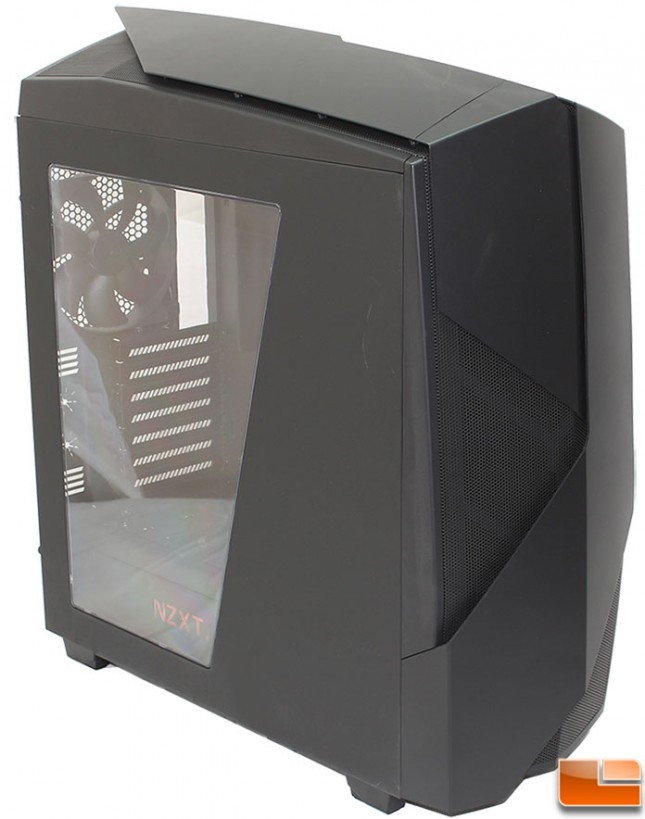
Taking a look at the exterior of the case, we can see a big change from the previous models. The top and front panels are no longer flat, they have wire mesh and plastic elements providing a new look. The Noctis 450 is still a mid-tower case, designed to support up to ATX motherboards. For storage, it has two 2.5″ drive trays located on top of the power supply shroud, and can also support up to six other 2.5″ or 3.5″ drives; there is no support for 5.25″ devices. Cooling options are plentiful with support for a total of up to seven 120mm fans, and support for up to two 360mm radiators; of course a fan controller is included to manage all those fans. NZXT kept the lighting capability from the previous models, with some enhancements, which we will discuss later.
image: http://www.legitreviews.com/wp-conte...re-645x224.jpg
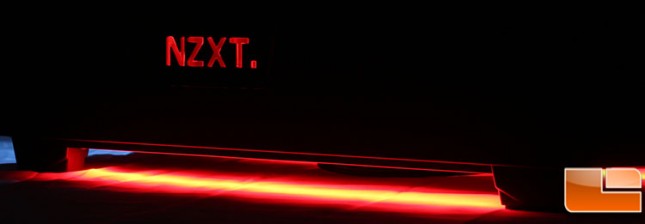
The Noctis 450 is available in two models, Glossy White with Blue LEDs which is sold under part number CA-N450W-W1, and Matte Black with Red LEDs with part number CA-N450W-M1. Both cases are currently available at well known etailers for under $139.99 with free shipping; making it over $20 more expensive than the older H440. Did the changes NZXT make warrant the price increase? Let’s take a look.
http://www.legitreviews.com/nzxt-noc...qB86jSAsFm4.99
-
04-06-15, 20:41 #52Tech Ubër-Dominus


- Registo
- Nov 2013
- Local
- City 17
- Posts
- 30,121
- Likes (Dados)
- 0
- Likes (Recebidos)
- 2
- Avaliação
- 1 (100%)
- Mentioned
- 0 Post(s)
- Tagged
- 0 Thread(s)
DeepCool Nephrite ITX Case Lets You Flaunt Your Graphics Card to the Max
Noticia:DeepCool, which is on a roll with cases such as the Tristellar, unveiled a slew of unique new case designs at Computex; beginning with the GamerStorm Nephrite. This slim, console-sized case, which measures 330 mm x 100 mm x 428 mm (DxWxH), features a two-compartment design, much like the ones we see in cases such as the RVZ02 by SilverStone, except for its asymmetric design, and its top (add-on card) compartment, which is transparent on three sides, letting you flaunt your high-end graphics card. So now, when you say your machine runs a GTX Titan X, or a Fury, you'll mean it.
The rest of the case is made of steel, with carbon fiber pattern cladding, cutouts at the right spots, and an interesting vent pattern. The motherboard tray seats a standard-height mini-ITX motherboard, with room for CPU coolers as tall as 120 mm, with a 120 mm fan mount right over it. You should have just enough room to stack an AIO liquid cooler block, with a 35 mm-thick radiator and one 25 mm-thick 120 mm spinner right over it. The case offers room for an SFX power supply. Now, if only NVIDIA bundled a $2 back-plate with its GTX Titan X, like it did with the GTX 980.



http://www.techpowerup.com/213177/de...o-the-max.html
-
05-06-15, 14:41 #53Tech Ubër-Dominus


- Registo
- Nov 2013
- Local
- City 17
- Posts
- 30,121
- Likes (Dados)
- 0
- Likes (Recebidos)
- 2
- Avaliação
- 1 (100%)
- Mentioned
- 0 Post(s)
- Tagged
- 0 Thread(s)
SilverStone Fortress FT05B-W Review
Review:The SilverStone Fortress FT05B is an unusual ATX case, as it has pretty much all the usual parts and features however they are not in the usual locations. Where the FT05B-W departs from the norm is the way the motherboard is rotated 90 degrees so the I/O panel sits at the top of the case.
This means that cooling air that usually enters from the front of the case is actually drawn in from the bottom and then blown vertically up the case by the two huge 180mm Air Penetrator fans (that’s £30 right there) that occupy the floor of the case. When you consider that hot air rises this arrangement makes perfect sense, however it also makes the design of the case a little complicated.
Watch via our VIMEO Channel (below) or over on YOUTUBE
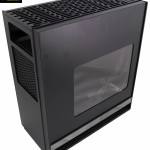
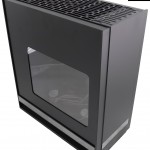
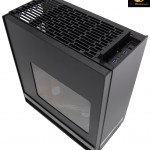
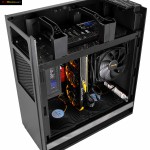
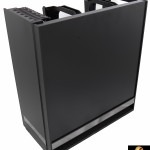
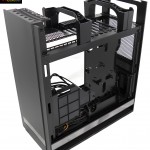
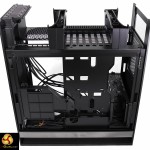
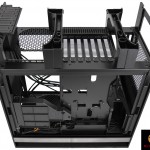
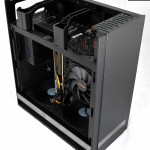
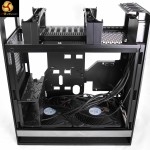
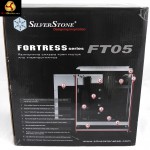
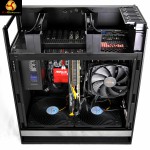
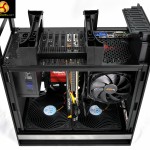
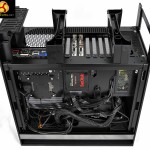
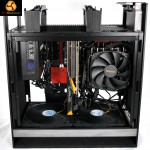
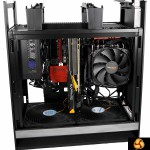
Specification:
- Motherboard support: ATX, Micro-ATX.
- Expansion slots: 7.
- Included fans: 2x 180mm bottom intake.
- Fan mounts: 3x 120mm/2x 140mm bottom intake, 1x 120mm top exhaust.
- 120mm radiator mounts: 120mm/240mm/360mm bottom, 1x 120mm top.
- 140mm radiator mounts: 140mm/280mm bottom.
- 5.25″ drive bays: 1 slimline
- Internal drive bays: 2x 3.5, 2×2.5″.
- Dimensions: 483mm H x 427mm D x 221mm W.
The top of the case lifts out to give you access to two hidden triggers which in turn release the side panels, and in this sentence we have a number of points that deserve some attention. The top cover is plastic and while it looks OK at first glance it isn’t especially classy. Added to that the cover is heavily ventilated but doesn’t have any filtering so while it works perfectly well with the fans blowing upwards it doesn’t offer any protection and absolutely means you don’t want to reverse the fans or mess with the cooling. SilverStone hasn’t taken leave of their senses as the intake on the underside of the case is fully protected by a long magnetically retained air filter.
The front and back panels of the case are machined from aluminium plate and your reviewer foolishly thought the side panels were also aluminium (they are pleasingly light weight) however they are actually sheet steel. Once you locate the side panel triggers and pull pretty darn hard the panels lift off to reveal the inside of the case. You are best advised to remove the tiny drive tower that holds two 3.5-inch drives and rely on the two 2.5-inch bays on the back of the motherboard tray. You may also prefer to lose the caddy for the slot loading DVD drive as it obscures the back of the CPU socket.
This opens the case up nicely and gives the airflow from those two huge fans a clear run, always provided you keep your cabling tidy. That isn’t such an easy task as there is no obvious place to stash the cables however we have faith you’ll manage one way or another.
It’s a shame the case is likely to look messy when you open it up as the styling is a large part of its charm. We rather liked the flip cover on the top of the case that covers the I/O panel and two fan control switches which each have three positions for high, medium and low.
Our FT05B-W (that’s B for Black and W for Window, an S means Silver) looks very appealing and also rather understated. It was unexpected to see the panel at the front of the case lights up when the system is turned on as it is connected to the Power LED header on the motherboard. Unfortunately you can see the rear of this panel through the side window and it looks a bit tacky.
You might, in theory, add a 120mm fan or radiator at the top of the case or you could swap out the two 180mm fans for a 120mm, 140mm, 240mm, 280mm or 360mm liquid cooler however this would make no sense. Those Air Penetrators work very well indeed and this means the FT05 case is the first case we have seen in ages that naturally lends itself to an air cooler on the CPU.
Testing
To put this case through its cooling paces we will be using a test system consisting of an Intel Core i7-4770K, Radeon R9 290 and an SSD drive. This system allows us to produce a substantial amount of heat and effectively test the SilverStone Fortress FT05‘s cooling capabilities.
For stress testing we use a mixture of AID64 and FurMark to create the maximum heat output. AIDA64 Stability Test allows us to stress our CPU. FurMark’s ‘GPU Burn-in’ mode creates the maximum amount of load our GPU is ever likely to see.
Test System:
- Processor: 3.9GHz Intel Core i7-4770K
- Motherboard: ASRock Z97 Killer
- CPU cooler: be quiet! Dark Rock TF
- Memory: Corsair Vengeance LP DDR3-1600MHz RAM
- Graphics card: Sapphire Tri-X R9 290
- Power supply: Seasonic Platinum Fanless 520W
- Storage drives: SanDisk Extreme Pro SSD
- OS: Windows 8.1 64-bit.
Cooling Performance

The Air Penetrator fans are big, effective and quiet so provided you use a sensible cooler on your CPU you really shouldn’t have any problems. The vertical airflow doesn’t seem to make any difference to our Sapphire R9 290 however the Tri-X cooler works well in the standard horizontal orientation and doesn’t really need any help from the SilverStone chassis.
Acoustics Performance

This is a quiet case. The baffled air intake at the bottom leads to two large, quiet fans with the option of fan speed control from the two flick switches on the top panel of the case. There is a certain amount of foam material inside the paneling but really it is the open design of the case and the lack of any vents at the sides that keeps it quiet.
It has to be said that if you stand over the top of the case you feel and hear the exhaust from the fans and power supply. This is not noisy but the airflow can get quite pronounced so you might want to consider where you locate the finished system.
Closing Thoughts
The SilverStone Fortress FT05B-W is an oddball of a case that is built around airflow through those two huge fans and onwards to a traditional heatsink style CPU cooler. The result is a vertical motherboard design and an unusual internal layout – however it is very effective and can be considered a success. On the downside the DVD bay holds a slimline drive, there isn’t much scope for adding multiple storage drives and those side panels require a firm upward pull to remove them.
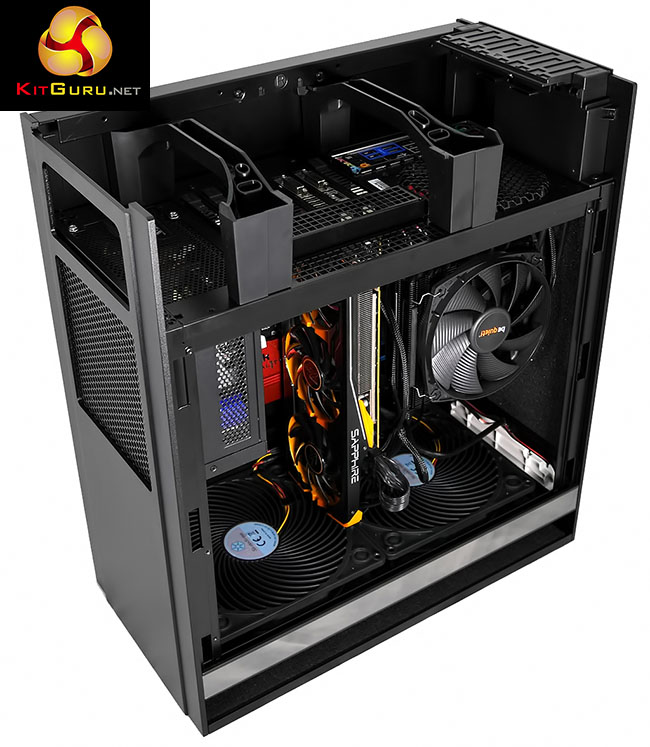
You have to accept the FT05 is built for airflow and styling with ease of build and convenience as relatively minor considerations. In that light the FT05 is a success, however it requires a fair amount of devotion when you build the new system.

Buy from Overclockers UK for £144.95 inc vat HERE.
Discuss on our Facebook page, over HERE.
Pros:
- 2x 180mm Air Penetrator fans.
- Fan control switches.
- Sleek styling.
- Impressive air flow.
- Two 2.5-inch SSD bays on the rear of the motherboard tray.
- Very quiet operation.
Cons:
- Top panel is plastic.
- Side panels require a firm upward pull.
- Cable management is unimpressive and there are no cable grommets.
- The DVD drive and 3.5-inch drive bays look like afterthoughts.
- Rather expensive.
http://www.kitguru.net/components/ca...t05b-w-review/
-
05-06-15, 14:44 #54Tech Ubër-Dominus


- Registo
- Nov 2013
- Local
- City 17
- Posts
- 30,121
- Likes (Dados)
- 0
- Likes (Recebidos)
- 2
- Avaliação
- 1 (100%)
- Mentioned
- 0 Post(s)
- Tagged
- 0 Thread(s)
Thermaltake accused of copying by boutique shop CaseLabs
Noticia:When Thermaltake announced one of its latest cases, the Suppressor F51, we noted that it bore more than a passing resemblance to Fractal Design's Define R5. The Suppressor might not be the only page that Thermaltake has lifted from other companies' design departments, though. Kevin Keating, a vice-president at boutique case manufacturer CaseLabs, accused Thermaltake of flat-out copying CaseLabs designs with its TT Premium W Series cases in this Facebook post, and he posted side-by-side pictures of CaseLabs cases and the TT Premium W Series enclosures to prove his point:
 TT Premium W Series cases on the left, CaseLabs cases on the right. Image: Kevin KeatingIt's pretty damning stuff, and angry enthusiasts are swamping Thermaltake's Facebook page in response. Nathan Kirsch at LegitReviews has also compiled a list of products with Thermaltake doppelgangers, and we have to admit that the resemblances to competitors' products don't stop with the Suppressor F51 or the W Series cases, either.
TT Premium W Series cases on the left, CaseLabs cases on the right. Image: Kevin KeatingIt's pretty damning stuff, and angry enthusiasts are swamping Thermaltake's Facebook page in response. Nathan Kirsch at LegitReviews has also compiled a list of products with Thermaltake doppelgangers, and we have to admit that the resemblances to competitors' products don't stop with the Suppressor F51 or the W Series cases, either.
Admittedly, there's only so much one can do to differentiate one PC case from another, but we'd certainly prefer that companies start with a clean sheet of paper and innovate from there, rather than with a photocopier. We'll keep an eye on this story for any further developments.
http://techreport.com/news/28409/the...-shop-caselabs
-
05-06-15, 18:57 #55Tech Ubër-Dominus


- Registo
- Nov 2013
- Local
- City 17
- Posts
- 30,121
- Likes (Dados)
- 0
- Likes (Recebidos)
- 2
- Avaliação
- 1 (100%)
- Mentioned
- 0 Post(s)
- Tagged
- 0 Thread(s)
The SilverStone Fortress FT05 Case Review
Toda a review:
SilverStone is a well-known manufacturer, distinguished for their atypical, strange case designs. The company offers numerous enclosures that partially or completely neglect the ATX design guide. The ML04 and ML05 that we reviewed several months ago are but a pair of examples of their HTPC solutions, while the Raven RV05 with its rotated motherboard tray was a prominent specimen of their unique tower designs. Today we are having a look at the Fortress FT05, a case very similar to the Raven RV05, although not quite the same.
The latest Fortress series case also has a rotated motherboard tray, a design that is inherited from the Raven RV01, but retains the compact dimensions of the Raven RV05. SilverStone boasts that the compact Fortress FT05 offers exceptional thermal performance and easy maintenance despite its compact proportions. However, that was the case with the Raven RV05 as well and our review revealed that this design is far from perfect. The Fortress FT05 retails at double the price tag of the Raven RV05 as well, making it a rather expensive small tower case, and a bit of an uphill battle for SilverStone.
Packaging & BundleSilverStone Fortress FT05 Specifications Motherboard Form Factor ATX, Micro-ATX, Mini-ITX Drive Bays External 1 x Slim Slot Loading Internal 2 x 3.5" (rear drive cage) 2 x 2.5" (rear of motherboard tray) Cooling Front - Rear - Top 1 x 120 mm (optional) Left Side - Bottom 2 x 180 mm (included) 3 x 120 mm or 2 x 140 mm fans can replace the stock fans Radiator Support Front - Rear - Top - Side - Bottom 240 mm / 280 mm I/O Port 2x USB 3.0, 1x Headphone, 1x Mic Power Supply Size ATX Clearances HSF 160 mm PSU 170 mm GPU 310 mm Dimensions 483 mm × 221 mm × 427 mm (H×W×D) 19 in × 8.7 in × 16.8 in (H×W×D) Prominent Features Aluminum wrap-around exterior with classic SilverStone Fortress styling
Revolutionary 90 degree motherboard mounting from RAVEN RV01
Breakthrough 5.25 inch bay-free design for unprecedented power to size ratio
Two Air Penetrator fans included for great performance and quietness
Positive air pressure design for excellent cooling/quietness and dust-prevention
Foam padded interior for advanced noise absorption
Quick-release latch for fast side panel removal
Exterior access to main filter for easy maintenance
Support for various liquid cooling radiator sizesPrice $180 Including Shipping (No Window)
$206.6 Including Shipping (With Window)
SilverStone supplies the Fortress FT05 in a large, dark cardboard box. There is little artwork to talk about, as the company limited it to a dark picture of the case itself. Thick Styrofoam slabs and a black nylon bag protect the case during shipping.
SilverStone supplies virtually only the hardware essential for the installation of the components, a few simple cable ties and a 120mm fan filter. There also is a very well written manual, but no extras such as cable straps or decorative stickers.
http://www.anandtech.com/show/9281/t...05-case-review
-
07-06-15, 15:17 #56Tech Ubër-Dominus


- Registo
- Nov 2013
- Local
- City 17
- Posts
- 30,121
- Likes (Dados)
- 0
- Likes (Recebidos)
- 2
- Avaliação
- 1 (100%)
- Mentioned
- 0 Post(s)
- Tagged
- 0 Thread(s)
Thermaltake CEO Kenny Lin: We created some memorable designs over the years
Noticia:At Computex 2015, KitGuru managed to catch up with Thermaltake CEO Kenny Lin. After a hiatus from product design, Kenny became very much more hands and a wave of new designs began to flow last year – including a KitGuru Annual Award for the Frio 14. In the Nangang Exhibition Hall this year, the emphasis is very much on creativity.
First, we asked Kenny about the new wave of product launches.
“We have been manufacturing unique products for 16 years and our passion is still as intense today as it was when we started”, he told us. “Our chassis designs plateaued after the Level 10, but last year we re-energised the chassis design team and the result was the stackable Core X case series, that has been really well received in all of our markets. Especially the Core X9 is a perfect chassis to go wild with our Pacific liquid cooling components”.
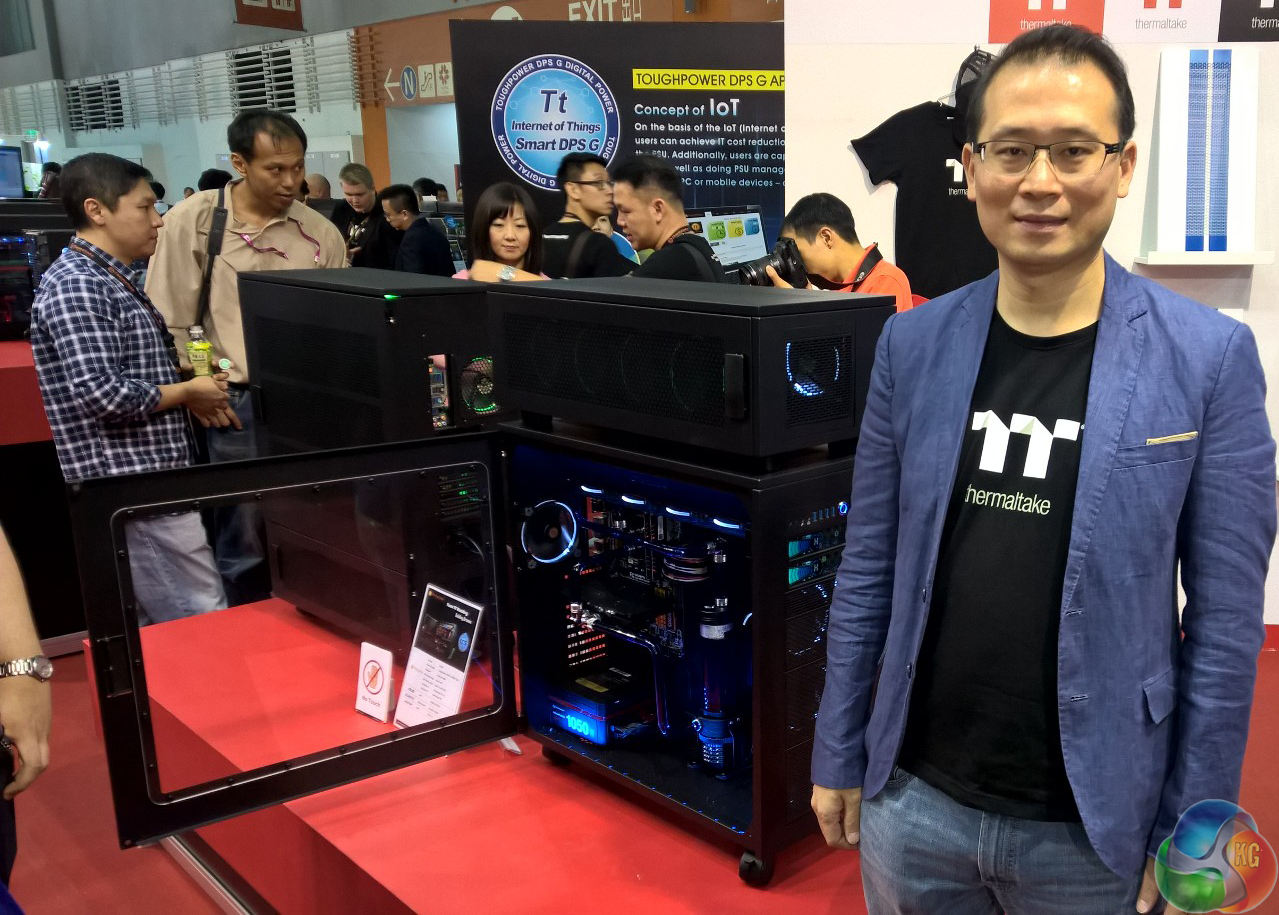
Surely one of the largest chassis ever produced is the latest ‘Core W’ dominates the stand at this year’s show.
“Thermaltake has created some memorable designs over the years”, said Kenny. “One that really stands out in people’s minds was the Mozart TX which we launched at CES in 2007 with 8 drive bays. Now, for Computex 2015, we have something even more substantial – the Core W Case Series”.
Do people really want this much space?
“Sure”, he exclaimed. “Over the past 12 months, our theme has been ‘expandability’, with cases that are easy to upgrade or even stack on top of each other”.
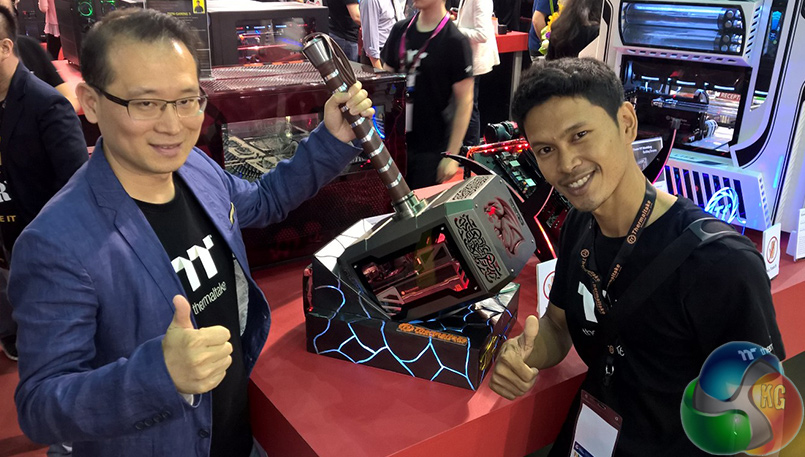
So is it all about the chassis?
“As well as the best range of cases that we’ve ever had, Thermaltake now also has a great range of water cooling products for advanced overclocking – something that will become more important with ASUS’s new launches in 2015”, he said.
With Luxa2, Thermaltake has touched lifestyle products already. What about other markets?
“The growth of the Tt eSports brand has also been amazing – especially when you consider how much competition there is in the market”, said Kenny. “Our new CONTOUR mobile gaming controller which has just received the APPLE MFI Certification will soon allow Apple enthusiasts world wide to experience a console-like gaming experience on their device when they want and where they want”.
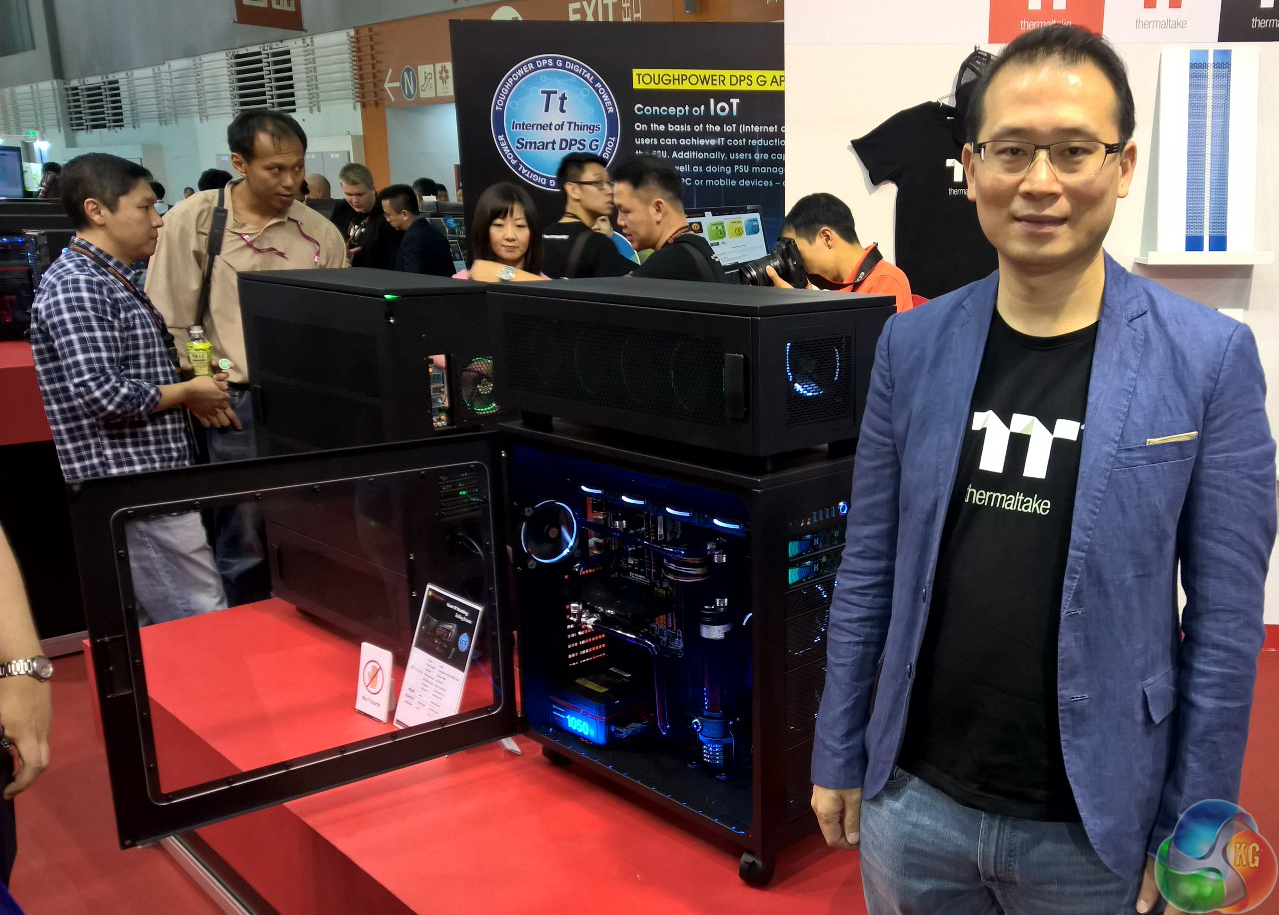
http://www.kitguru.net/components/ca...ver-the-years/
-
08-06-15, 15:02 #57Tech Ubër-Dominus


- Registo
- Nov 2013
- Local
- City 17
- Posts
- 30,121
- Likes (Dados)
- 0
- Likes (Recebidos)
- 2
- Avaliação
- 1 (100%)
- Mentioned
- 0 Post(s)
- Tagged
- 0 Thread(s)
BitFenix Aegis Micro-ATX Pictured in Five Color Options
Noticia:BitFenix unveiled its Aegis line of micro-ATX cases in five color options - black, white, red, blue, and yellow. The cases feature glossy-black front, with glossy plasticky sides and top. The color shades look much like the ones you'd find on a Lumia or an iPhone 5C. The case offers a spacious micro-ATX motherboard tray with five expansion slots (so you can use a dual-slot graphics card installed on the bottom-most slot of your motherboard); with room for CPU coolers as tall as 170 mm, and graphics cards as long as 380 mm.
Storage spaces include four each of 3.5-inch and 2.5-inch drive bays, in detachable drive cages. Much like the Pandora ATX, it offers a 4-channel PWM fan-controller, with a 2.8-inch LCD display. Cooling includes three 120 mm front intakes (which convert to two 140 mm); and a similar vent cluster on the top; a 140 mm bottom intake, and a 120 mm rear exhaust. You can install 3x 120 mm or 2x 140 mm radiators on the front and top vents. 360 mm dust filters cover the front and top vents.




http://www.techpowerup.com/213273/bi...r-options.html
-
08-06-15, 20:00 #58Tech Ubër-Dominus


- Registo
- Nov 2013
- Local
- City 17
- Posts
- 30,121
- Likes (Dados)
- 0
- Likes (Recebidos)
- 2
- Avaliação
- 1 (100%)
- Mentioned
- 0 Post(s)
- Tagged
- 0 Thread(s)
In Win 707
Toda a review:Introduction
I would like to thank In Win for supplying the review sample.

Having reviewed the In Win 703 (read our review here), the In Win 707 is a larger version of the same chassis with more space, a larger number of expansion slots, and liquid-cooling possibilities. As it is a part of the 70X series of enclosures, In Win is also offering it in two color combinations: black and red or white and black. We got the black and red version for review today.
SpecificationsIn Win 707 Full-Tower Steel, Aluminum & Plastic 11.4 kg 8 3x External 5.25"
8x Internal 2.5/3.5"E-ATX / ATX / Micro-ATX 210(W) x 475(H) x 480(D) YES 140mm x 2 (included) 140mm x 1 (included) 120mm x 3 (optional) 120mm or 140mm Fan x 2 120mm or 140mm x 1 120mm or 140mm x 1 2x USB 3.0
2x USB 2.0
1x Headphone
1x MicrophoneN/A CPU Cooler: 206 mm
GPU: 365 mm

http://www.techpowerup.com/reviews/InWin/707/1.html
-
09-06-15, 14:30 #59Tech Ubër-Dominus


- Registo
- Nov 2013
- Local
- City 17
- Posts
- 30,121
- Likes (Dados)
- 0
- Likes (Recebidos)
- 2
- Avaliação
- 1 (100%)
- Mentioned
- 0 Post(s)
- Tagged
- 0 Thread(s)
Antec’s Signature S10 is a $500 Uber Case
Noticia:Antec’s once-iconic cases have gone through several design evolutions in the last years but their Signature Series is now making a comeback with the $500 S10.
If anything the S10 is a unique chassis, albeit an expensive one at $499. It has an extremely clean and sleek exterior design which is a huge departure from some of the more eclectic designs we’ve seen from them in the past and has amazing build quality.
So other than build quality, what makes the S10 worthy such a high price? There are innovative magnetic mounting strips for the side panels, a unique heat segregation system and multiple separate ventilation zones, one of the cleanest interiors we have ever seen, multiple areas for water cooling setups and a hub which controls a whopping 10 fans. All in all, the S10 looks interesting and it hopefully represents a new direction for Antec’s case lineup.
Make sure to check out our video of it above.
http://www.hardwarecanucks.com/news/...500-uber-case/
-
09-06-15, 21:14 #60Tech Ubër-Dominus


- Registo
- Nov 2013
- Local
- City 17
- Posts
- 30,121
- Likes (Dados)
- 0
- Likes (Recebidos)
- 2
- Avaliação
- 1 (100%)
- Mentioned
- 0 Post(s)
- Tagged
- 0 Thread(s)
Bitfenix Aegis Mid-tower Case Review
Toda a review:I have seen some very cool customized cars at car shows and community events. Some of the builds involve getting a larger engine to fit into the chassis of a smaller vehicle. The people who manage to fit those components into the smaller cars impress me, and it proves that you are only limited by your imagination and determination, to some degree. Computer modders can be equally impressive in what they manage to cram into certain chassis. Not all of us have the talent to mod a case to our desire, so we look for stock cases that have some flashiness and the features we need. Like with cars, you don’t always need the biggest chassis to fit your components. The Bitfenix Aegis is just that, a smaller mid-tower chassis with the flexibility to mount a full custom liquid cooling loop. The Aegis supports up to seven 120mm fans or five 140mm fans, dual 280mm radiators and even locations for a 360mm radiator. Bitfenix has provided support for Micro-ATX and mini-ITX motherboards with the Aegis. The drive bays are also flexible, with support for four 3.25” drives and three 2.5” drives. In fact, you can remove all the drive bays and still use one 2.5” drive to build your show piece. While there is a lot of support for liquid cooling systems, you can’t forget the air cooling potential, as well; support for seven 120mm fans or five 140mm fans, CPU coolers to 170mm in height, and GPU lengths to 380mm in length.
The Bitfenix Aegis Mid Tower Case Overview and Installation
- Introduction: 0:00 - 1:05
- Case Features: 1:25 - 9:39
- Benchmarks: 9:40 - 9:50
- Conclusion: 9:51 - 12:09
Photo Gallery
Specifications

http://www.hitechlegion.com/reviews/...er-case-review
Informação da Thread
Users Browsing this Thread
Estão neste momento 1 users a ver esta thread. (0 membros e 1 visitantes)




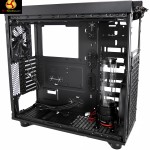
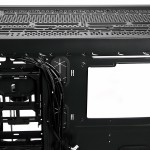
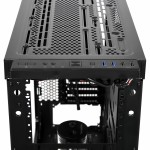
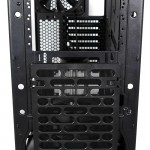
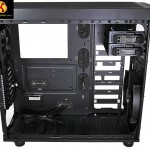
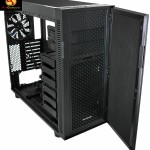
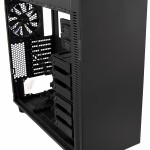
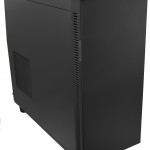

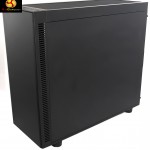
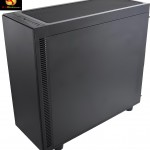
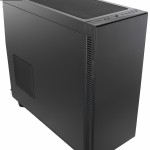
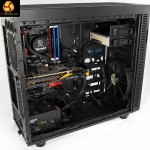
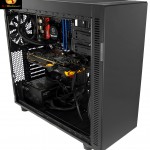
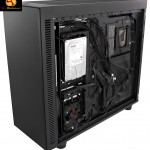
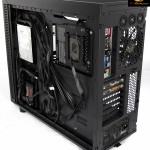
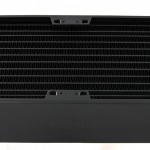
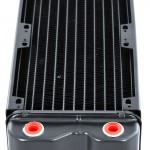
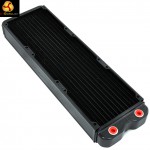
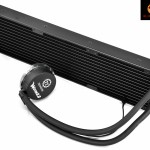
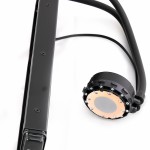
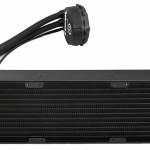
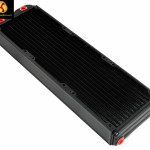
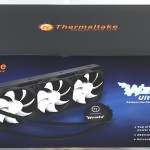
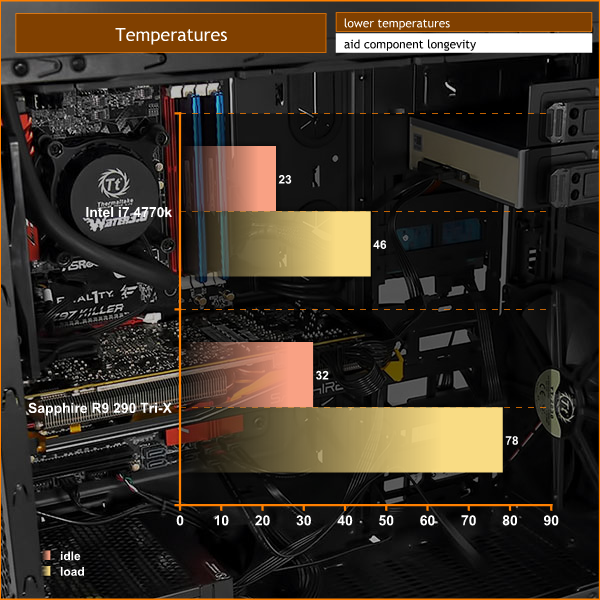
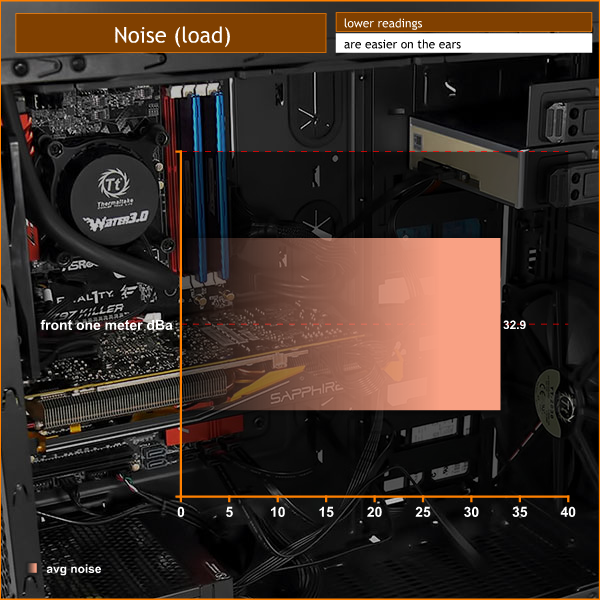
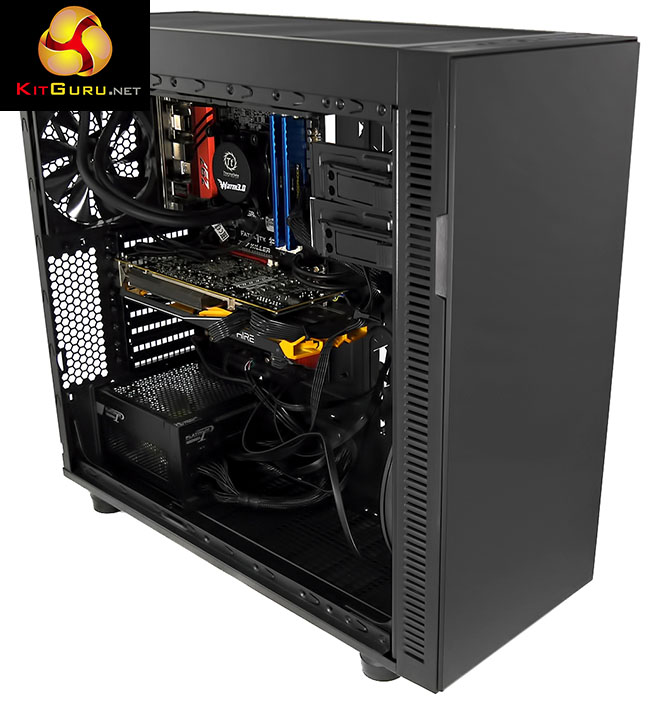


 Responder com Citação
Responder com Citação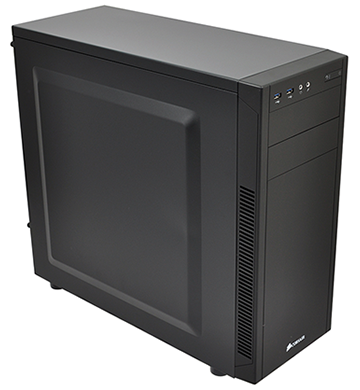
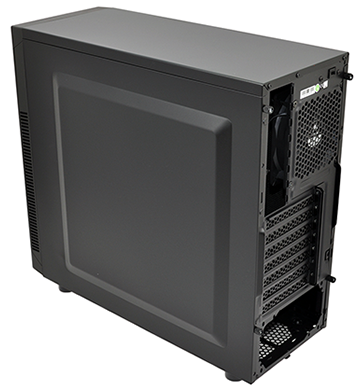
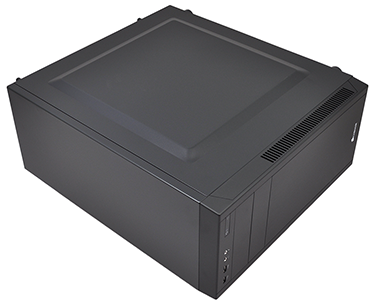
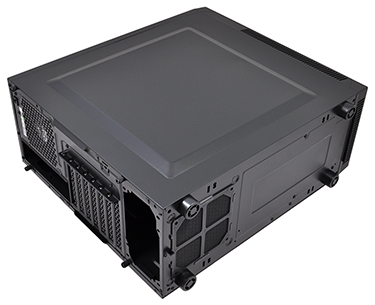
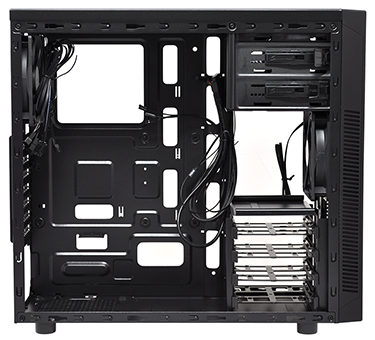

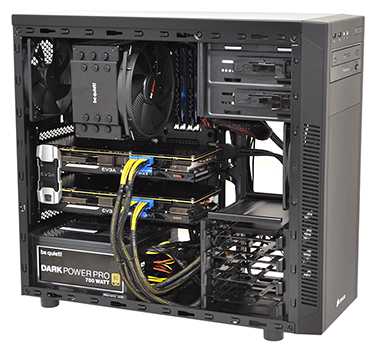
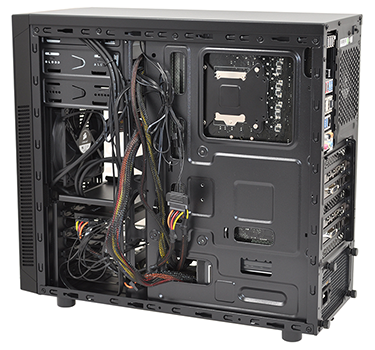

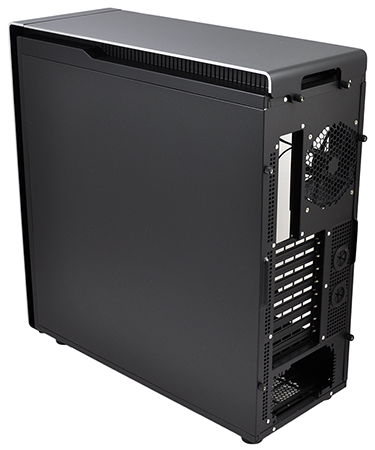
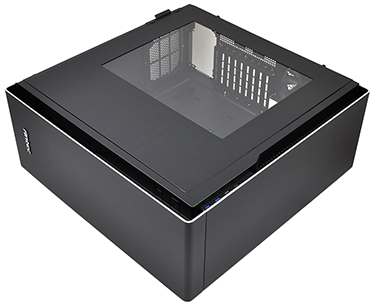

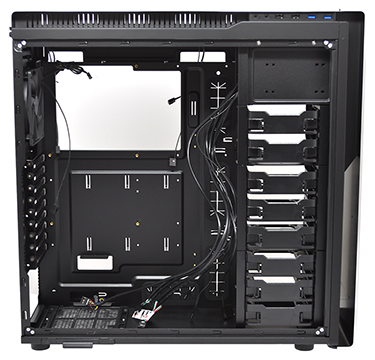

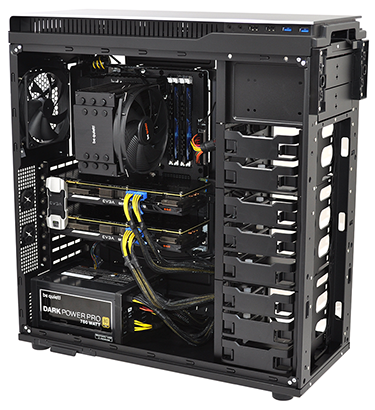
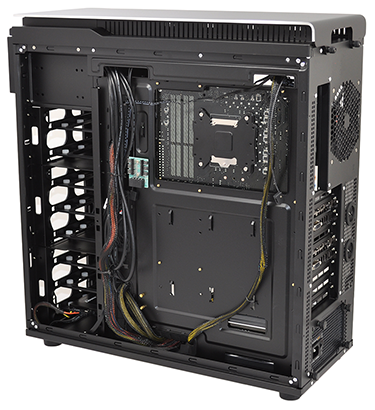
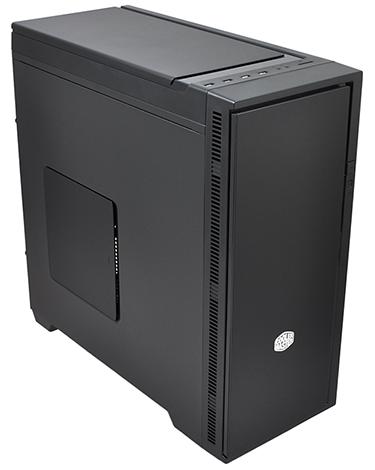
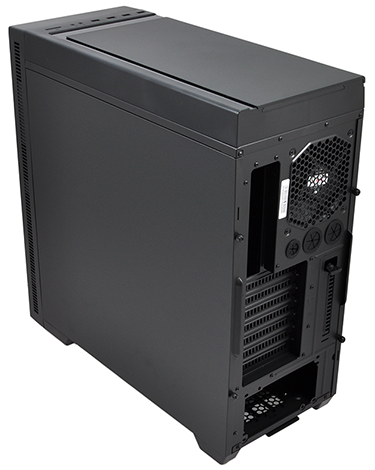

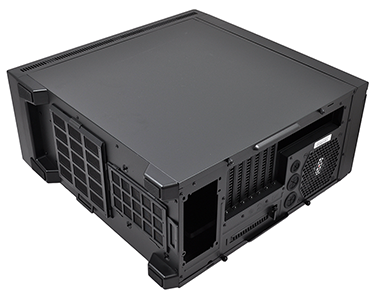

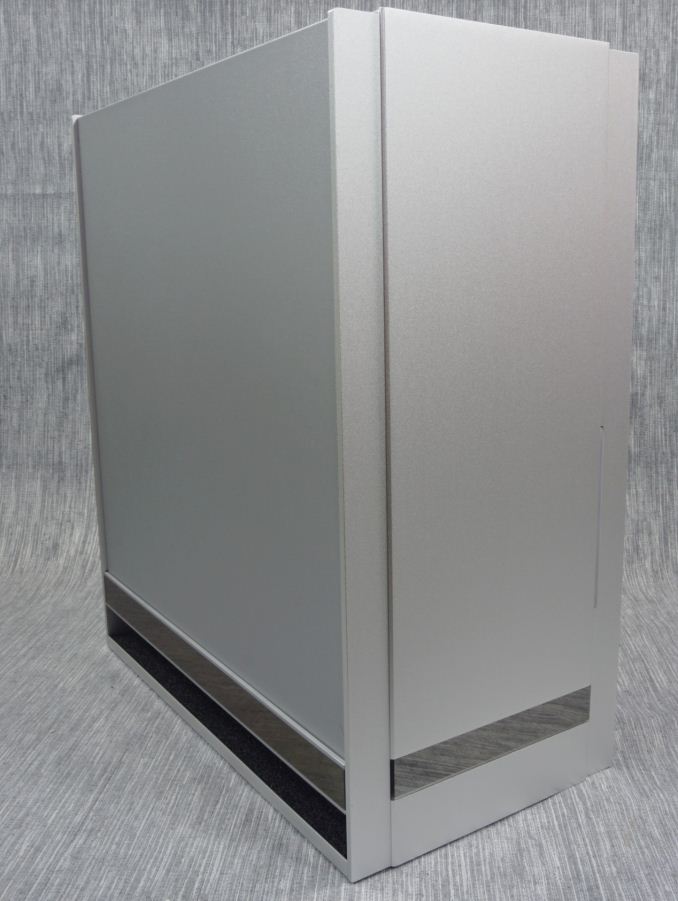









Bookmarks